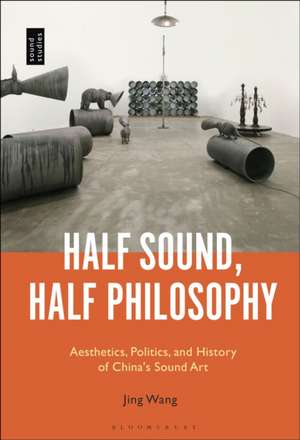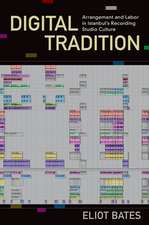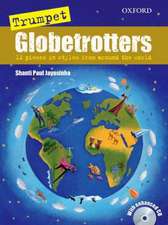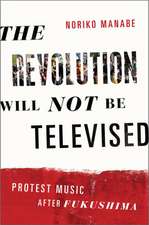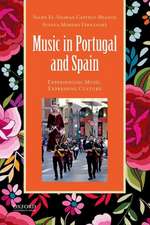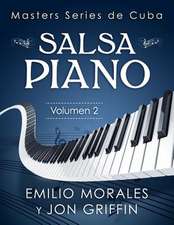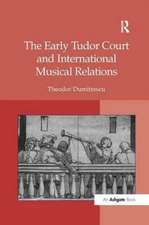Half Sound, Half Philosophy: Aesthetics, Politics, and History of China's Sound Art
Autor Professor Jing Wangen Limba Engleză Paperback – 24 aug 2022
| Toate formatele și edițiile | Preț | Express |
|---|---|---|
| Paperback (1) | 197.34 lei 6-8 săpt. | |
| Bloomsbury Publishing – 24 aug 2022 | 197.34 lei 6-8 săpt. | |
| Hardback (1) | 568.48 lei 6-8 săpt. | |
| Bloomsbury Publishing – 10 feb 2021 | 568.48 lei 6-8 săpt. |
Preț: 197.34 lei
Preț vechi: 257.63 lei
-23% Nou
Puncte Express: 296
Preț estimativ în valută:
37.76€ • 39.53$ • 31.24£
37.76€ • 39.53$ • 31.24£
Carte tipărită la comandă
Livrare economică 05-19 aprilie
Preluare comenzi: 021 569.72.76
Specificații
ISBN-13: 9781501374777
ISBN-10: 150137477X
Pagini: 232
Dimensiuni: 152 x 229 mm
Greutate: 0.32 kg
Editura: Bloomsbury Publishing
Colecția Bloomsbury Academic
Locul publicării:New York, United States
ISBN-10: 150137477X
Pagini: 232
Dimensiuni: 152 x 229 mm
Greutate: 0.32 kg
Editura: Bloomsbury Publishing
Colecția Bloomsbury Academic
Locul publicării:New York, United States
Caracteristici
Presents
insight
into
the
aesthetic,
technological,
and
ideological
connections
between
sound
practices
in
China,
Japan,
Europe,
and
the
United
States
Notă biografică
Jing
Wangis
Associate
Professor
in
the
College
of
Media
and
International
Culture
at
Zhejiang
University,
China.
She
is
an
art
anthropologist,
sound
studies
scholar,
sound
event
curator.
She
completed
her
PhD
in
the
school
of
Interdisciplinary
arts
at
Ohio
University.
She
was
a
visiting
professor
at
MIT
anthropology
(2019-2020).
Artistically,
Jing
(Adel)
works
with
field-recordings
and
installation-based
performance.
In
January
2015,
she
foundedThe
Sound
Labat
College
of
Media
and
International
Culture
at
Zhejiang
University.
Cuprins
AcknowledgementsList
of
IllustrationsIntroduction1.
Sound,
Resonance,
the
Philosophy
ofQiAncient
Chinese
AcousticsThe
Philosophy
ofQiSound
Explained
ThroughQi-PhilosophyConclusion2.
A
Brief
History
of
Sound
in
China's
Contemporary
Art
Conditions
and
Precursors
New
Media
Art
After
2000
Sound
Art
after
20003.
A
Brief
History
of
Electronic
and
Experimental
Music
in
China
The
Electronic
Instrument
Builders
Academic
Electronic
Music:
Inauguration
Non-Academic
Electronic
and
Experimental
Music
Conclusion4.Shanshui-Thought
in
Experimental
Music
PracticeShanshui-Thought:
An
OverviewShanshui:
The
Existential
and
the
Epistemological
MakingShanshui-Thought
Audible:
Two
Aesthetic
QualitiesConclusion
5.
In
Praise
of
Strange
Sounds
of
the
Shamanistic
The
Minor
Tradition
in
Ancient
Chinese
Culture:
Shamanism
andChimei
WangliangAcoustic
Cultural
Heritage
and
NationalismHuanghuand
Its
Two
Aesthetic
Operations
of
Resonance
and
WithdrawalConclusion6.
Ubiquitous
Control:
From
Cosmic
Bell,
Loudspeakers
to
Immanent
Humming
Zhang
Peili
and
Anti-monumentality
of
Sound
Zhang
Ding
and
the
Military-entertainment-art
Complex
Liu
Chuang
and
the
(Im)Possibility
of
Not
Being
Governed
Conclusion:Qi-Thinking,
or
Cybernetics:
A
way
of
Going
OnGlossary
of
TermsBibliographyIndex
Recenzii
In
this
book,
WANG
Jing
offers
the
reader
the
unique
opportunity
to
investigate
sonic
creativity
within
but
mainly
outside
of
academe
in
China
ranging
from
sound
art
to
experimental
and
electroacoustic
music
to
DIY
culture
and
electronic
instrument
building.
The
historical
discussion
covers
much
ground
but
is
not
restricted
to
a
multi-strand
survey.
Key
to
her
approach
is
the
investigation
of
Chinese
cultural
and
philosophical
elements
that
permeate
this
substantial
body
of
creative
work
demonstrating
beyond
any
doubt
that
experimentalism
with
sound
in
China
is
hardly
a
simple
reflection
of
developments
from
other,
mainly
western
countries
but
is
instead
largely
deeply
rooted
in
Chinese
traditions,
some
ancient,
related
to
sound,
toqiand
much
more.
If sound isqi, resonating, Chinese sound art animated byqilives in the resonances that arise in the mutating, overlapping atmospheres of state power plays and works of artistic resistance. In this stunning book, Jing Wang audits pieces that mobilize clock hearts, crowd shouts, cybernetic dissonance, and strategic silence to jolt us into an active attention to how violence and defiance are made and born in the ambient sounds of everyday life.
Half Sound, Half Philosophyis the first major study of Chinese sound art and its affinity to ancient Qi-philosophy, an organic, holistic and enchanted worldview that stands in marked contrast to the commercialism and individualization of post-Mao China. Erudite and being attuned to the subtle play of resonances and the subliminal in the acoustics of Qi, Wang's book is destined to become a classic of sound art scholarship and sound studies more broadly.
Wang's timely publication is a must read for anyone interested in a transnational perspective on sound.
Half Sound, Half Philosophycontributes a uniquely ambitious and essential entry into the emerging literature on sound in East Asia. Wang's rich scholarly analysis extends the core tenets ofqias acoustical thought into a contemporary history of electronic music and sound artists, revealing the deep roots of sonic philosophy in Chinese conceptual and creative practices.
If sound isqi, resonating, Chinese sound art animated byqilives in the resonances that arise in the mutating, overlapping atmospheres of state power plays and works of artistic resistance. In this stunning book, Jing Wang audits pieces that mobilize clock hearts, crowd shouts, cybernetic dissonance, and strategic silence to jolt us into an active attention to how violence and defiance are made and born in the ambient sounds of everyday life.
Half Sound, Half Philosophyis the first major study of Chinese sound art and its affinity to ancient Qi-philosophy, an organic, holistic and enchanted worldview that stands in marked contrast to the commercialism and individualization of post-Mao China. Erudite and being attuned to the subtle play of resonances and the subliminal in the acoustics of Qi, Wang's book is destined to become a classic of sound art scholarship and sound studies more broadly.
Wang's timely publication is a must read for anyone interested in a transnational perspective on sound.
Half Sound, Half Philosophycontributes a uniquely ambitious and essential entry into the emerging literature on sound in East Asia. Wang's rich scholarly analysis extends the core tenets ofqias acoustical thought into a contemporary history of electronic music and sound artists, revealing the deep roots of sonic philosophy in Chinese conceptual and creative practices.
